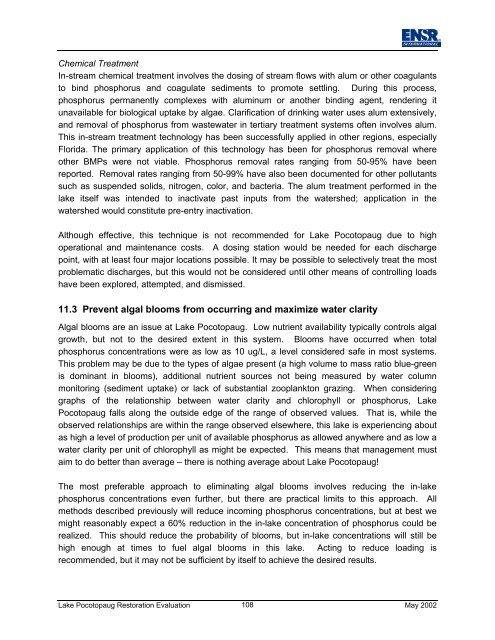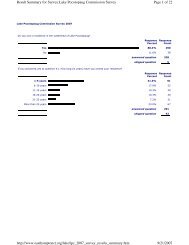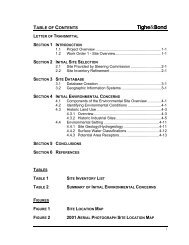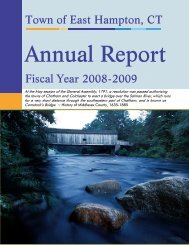Lake Pocotopaug Lake and Watershed Restoration Evaluation ...
Lake Pocotopaug Lake and Watershed Restoration Evaluation ...
Lake Pocotopaug Lake and Watershed Restoration Evaluation ...
Create successful ePaper yourself
Turn your PDF publications into a flip-book with our unique Google optimized e-Paper software.
Chemical TreatmentIn-stream chemical treatment involves the dosing of stream flows with alum or other coagulantsto bind phosphorus <strong>and</strong> coagulate sediments to promote settling. During this process,phosphorus permanently complexes with aluminum or another binding agent, rendering itunavailable for biological uptake by algae. Clarification of drinking water uses alum extensively,<strong>and</strong> removal of phosphorus from wastewater in tertiary treatment systems often involves alum.This in-stream treatment technology has been successfully applied in other regions, especiallyFlorida. The primary application of this technology has been for phosphorus removal whereother BMPs were not viable. Phosphorus removal rates ranging from 50-95% have beenreported. Removal rates ranging from 50-99% have also been documented for other pollutantssuch as suspended solids, nitrogen, color, <strong>and</strong> bacteria. The alum treatment performed in thelake itself was intended to inactivate past inputs from the watershed; application in thewatershed would constitute pre-entry inactivation.Although effective, this technique is not recommended for <strong>Lake</strong> <strong>Pocotopaug</strong> due to highoperational <strong>and</strong> maintenance costs. A dosing station would be needed for each dischargepoint, with at least four major locations possible. It may be possible to selectively treat the mostproblematic discharges, but this would not be considered until other means of controlling loadshave been explored, attempted, <strong>and</strong> dismissed.11.3 Prevent algal blooms from occurring <strong>and</strong> maximize water clarityAlgal blooms are an issue at <strong>Lake</strong> <strong>Pocotopaug</strong>. Low nutrient availability typically controls algalgrowth, but not to the desired extent in this system. Blooms have occurred when totalphosphorus concentrations were as low as 10 ug/L, a level considered safe in most systems.This problem may be due to the types of algae present (a high volume to mass ratio blue-greenis dominant in blooms), additional nutrient sources not being measured by water columnmonitoring (sediment uptake) or lack of substantial zooplankton grazing. When consideringgraphs of the relationship between water clarity <strong>and</strong> chlorophyll or phosphorus, <strong>Lake</strong><strong>Pocotopaug</strong> falls along the outside edge of the range of observed values. That is, while theobserved relationships are within the range observed elsewhere, this lake is experiencing aboutas high a level of production per unit of available phosphorus as allowed anywhere <strong>and</strong> as low awater clarity per unit of chlorophyll as might be expected. This means that management mustaim to do better than average – there is nothing average about <strong>Lake</strong> <strong>Pocotopaug</strong>!The most preferable approach to eliminating algal blooms involves reducing the in-lakephosphorus concentrations even further, but there are practical limits to this approach. Allmethods described previously will reduce incoming phosphorus concentrations, but at best wemight reasonably expect a 60% reduction in the in-lake concentration of phosphorus could berealized. This should reduce the probability of blooms, but in-lake concentrations will still behigh enough at times to fuel algal blooms in this lake. Acting to reduce loading isrecommended, but it may not be sufficient by itself to achieve the desired results.<strong>Lake</strong> <strong>Pocotopaug</strong> <strong>Restoration</strong> <strong>Evaluation</strong> 108May 2002







